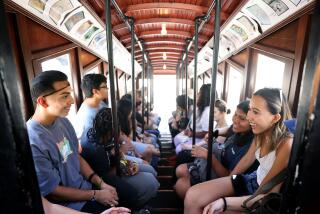Lessons in Diversity : Ethnicity: Two Latino high school students return from a visit to Taiwan with changed viewpoints about Asians. Now they are peer counselors working to ease racial tensions.
SAN GABRIEL â Sophomore Pauline Torres used to have some resentment about Asian-born students at San Gabriel High School--the way many have expensive cars like BMWs, the way they sometimes drive those cars recklessly, even the way their high grades often throw off the academic curve in classrooms.
Then, her older brother, 11th-grader Raymond Torres, visited Taiwan on a cultural exchange mission and learned that most Chinese students get what they have by working hard and sacrificing fun for study. He also told his sister that Taiwan has few traffic signals and so people drive wherever they can, even on sidewalks.
And, she said, Raymond believes everyone at school should try to learn from ethnic diversity.
âHe changed,â Pauline Torres said of her brother after his trip. âHe cherishes what we have hereâ in diversity, she said, noting how he helped her shake some of her prejudices.
In August, Raymond Torres and senior Blanca Saldana were invited to join a 12-member delegation to Taiwan for a two-week visit organized by the Chinese American Parents and Teachers Assn. of Southern California. The $42,000 group trip was funded by four San Gabriel Valley sister cities in Taiwan and donations from community groups and individuals.
This year, Torres and Saldana are working as peer counselors, trying to sort out problems between Latino and Asian students. Next summer, the association will send two Asian students to Mexico.
The association is trying to help ease racial tensions at San Gabriel High School, where two widely reported fights broke out in March, 1991. Two Chinese brothers were beaten by a group of Latinos in one fight, and in the other, four Vietnamese students attacked two Anglos.
In both cases, racial epithets were exchanged, although school officials downplayed the racial nature of the fights. School officials suspended some of those involved, and the district attorneyâs office filed misdemeanor battery charges against several teen-agers.
The Taiwan trip is one example of the associationâs effort to involve students in cultural exchanges. Besides Torres and Saldana, the delegation included representatives from three local school districts and from the Los Angeles County Human Relations Commission.
Delegates visited a high school, elementary school and the department of education, and they stayed with host families. All 12 delegates are working on trip journals that will be published in a pamphlet for schools, said Marina Tse, association president.
Although there apparently have been no major ethnic-related incidents since the 1991 fights, students say tensions still are high. The 3,200-student high school is 44% Asian, 43% Latino, 9% Anglo and 4% other.
âTo me, it feels like a dormant volcano or The Big One--itâs going to happen sometime,â said Brian Dario, a 12th-grade student.
Dario said he wishes school officials would do more to bring students together.
âThe best thing . . . was sending Ray and Blanca to Asia,â Dario said. âI thought that was awesome. . . . Rayâs attitude changed a lot when he came back. He had a whole new respect for their culture.
âHe was telling me about the things they experienced, the things they did, and maybe he didnât like it, but he understood it better. Itâd be kind of cool if you could send all the Latinos to Asia and all the Asians to Mexico or whatever, but thatâs unrealistic.â
Torres and Saldana say they talk up the Taiwan trip to their friends and others in peer counseling. In the program, students study how to become counselors and work with other students who come to them with problems or are assigned to them by school counselors. Sometimes, Latino students approach Torres and Saldana, complaining about Asians.
âIâve talked about this to some of my friends who are Mexican,â Torres said. âTo tell you the truth, some of them are jealous because Asians are getting high test scores and stuff like that. I tell them itâs true that, as Mexicans, we donât study enough.â
Torres tells his friends that he saw Chinese students studying until midnight and going to school seven days a week.
âMe, living here, I could never understand why they had everything--cars and everything, but now that we went to Taiwan and saw their schools, and how they study, I can understand that they come over here and they work real hard, real hard to get where they are,â Torres said. âNow, I understand how they get all that.â
Saldana said, âIâve heard a lot of Hispanics saying, âThey get everything. They get the best. They have the best.â They donât understand why, or they donât know that since the Asians (were young) they get into their heads that they have to study, and they have to have an education. So I think thatâs why (there is) a lot of misunderstanding.â
A few Chinese students gave Saldana a hard time in her Mandarin class at school, in which she was the only non-Asian student. She got Aâs in the class.
âIn my class, they were saying, âIf youâre not an Asian, how can you be getting better grades?â â Saldana said. âA lot of them thought the teacher was on my side, that he was helping me. . . . Some of them were very nice to me. The others were rejecting me, like if I didnât pronounce something right, they would laugh at me.â
Some Asians also have stereotypes about Latinos, said junior Jamie Nguyen, a Vietnamese-American.
One is âthat they donât go to school,â Nguyen, 16, said, reflecting what she hears. Another is âthat they just party.â
Nguyen, who is in a peer counseling class, has suggested to her teacher that a schoolwide assembly might help air ethnic misunderstandings.
âThere are a lot of people here that are very open-minded,â Nguyen said. âThere are a lot of people that are very close-minded and hang out with people from their own race.â
During a recent lunch period, Torres pointed out tables of separate black students, Asian students and Latino students.
âYou kinda see how everyone sticks to their own groups?â he said. âEveryone sticks to races.â
He stopped to greet his sister and friends, who were being chastised by a school security officer for throwing food. Then he gestured toward another table of four Vietnamese boys who were quietly reading textbooks and writing in their three-ring binder notebooks.
âSee how theyâre studying at lunch?â he said, shaking his head. âEveryone else, talking and laughing.â
More to Read
Sign up for Essential California
The most important California stories and recommendations in your inbox every morning.
You may occasionally receive promotional content from the Los Angeles Times.










